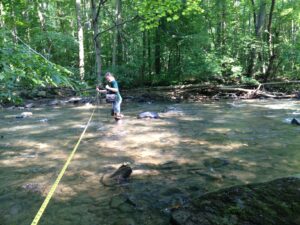We spent much of last week conducting our quarterly water sampling in the Yough. We sample 17 sites from the mouth in Allegheny County upstream into Maryland. We sample nine locations along the main stem and on eight major tributaries– Sewickley Creek, Jacob’s Creek, Mount’s Creek, Dunbar Creek, Indian Creek, Meadow Run, Laurel Hill Creek and the Casselman River.
Two Rivers Conservation Plans, the Middle and Lower Yough, strongly recommended a “scientific comprehensive water quality monitoring program be established for the Yough River.” While we currently only have funds to sustain our monitoring for two years, we are hopeful we’ve begun to establish a current baseline for water quality throughout the basin. We sample for 28 parameters plus five field parameters, and we also measure the flow.
Summer 2013 was our fifth round of sampling; we began sampling quarterly in July 2012. Some trends we’ve noticed so far:
- Water quality is generally good throughout the watershed.
- pH generally ranges from 6.8 to 8.3. It’s usually a bit higher on the tribs than in the main stem of the Yough.
- E-coli is problematic in some parts of the basin, especially during low flows.
- Total dissolved solids (TDS) and conductivity increase as you move downstream on the Yough and are high in some of the tribs, particularly Sewickley Creek.
- The river is cold– especially upstream. We see the coldest temperature in Confluence below the dam (last week it was 14.2C/57.6F) and the warmest at the mouth (23.7C/74.6F). The warmest temperatures we found last week were on the Casselman River — 28.8C/83.8F (though keep in mind the air temperature was also approximately 83F while we were sampling).
- We see very low levels of aluminum, arsenic, lead and selenium throughout the basin.
While traveling throughout the watershed, we’re reminded of how much work there is to do. A lot of untreated mine drainage continues to flow into the Yough. Several municipalities are struggling to adequately treat their sewage. In many locations, sewage overflows continue to occur during heavy rainfall.
And yet we also see a lot of cooperative efforts to improve water quality. Mine drainage treatment and stormwater management systems exist throughout the basin, constructed and maintained by watershed groups including ours— and also Casselman River Watershed Association, Jacobs Creek Watershed Association, Chestnut Ridge Trout Unlimited and Sewickley Creek Watershed Association.
If you’re interested in learning more about our comprehensive water quality monitoring plan or if you would like to volunteer please contact Krissy. You can also make a donation to our Yough Defense Fund to support the continuation of this project. Thank you!




